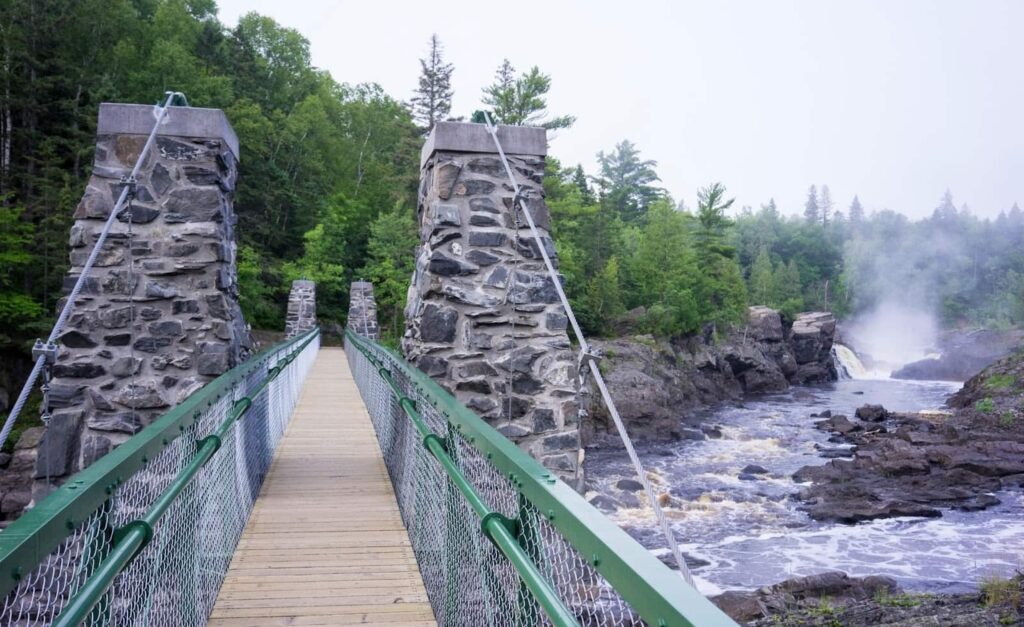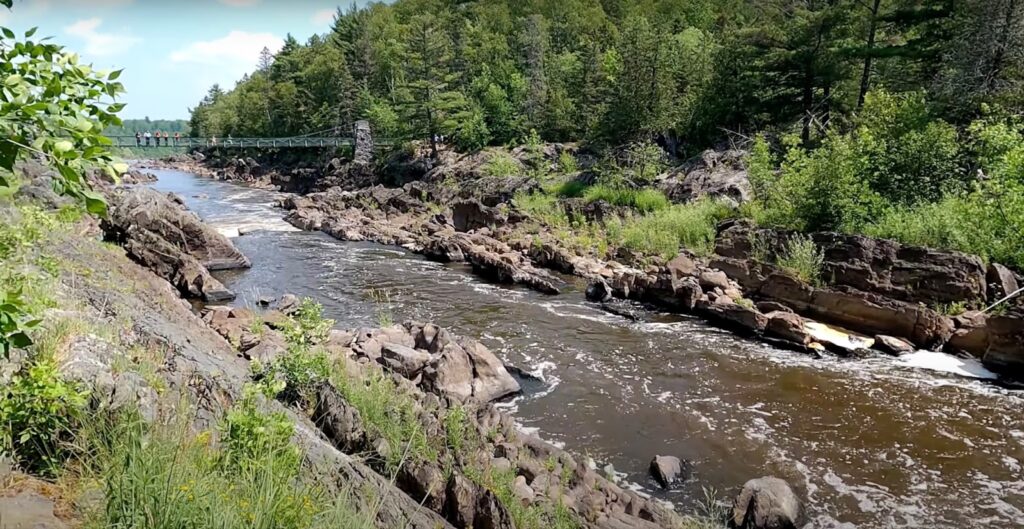Nestled in the heart of northern Minnesota’s Carlton County, Jay Cooke State Park encompasses over 8,500 acres of pristine wilderness, rugged cliffs, cascading waterfalls, and meandering rivers. Named after Jay Cooke, a prominent banker and financier who played a pivotal role in the establishment of the national park system, this park showcases the magnificent natural beauty of the St. Louis River Valley.
Geological History and Topography
Glacial Influence
Jay Cooke State Park is a testament to the ancient geological forces that shaped its landscape. The area was once covered by glaciers, which carved out the deep valleys and towering cliffs that characterize the park. The St. Louis River, a major waterway in the region, flows through the park, creating scenic waterfalls and rapids along its course. The park’s topography offers a diverse array of habitats, including deciduous forests, coniferous forests, wetlands, and open meadows. The elevation ranges from 600 feet above sea level at the river’s edge to over 1,000 feet on the plateau above.
Water Features
One of the most striking features of Jay Cooke State Park is the Upper St. Louis River Gorge. This rugged canyon is over a mile long and features vertical cliffs that rise over 400 feet above the river. The gorge is home to several waterfalls, including the stunning Bridal Veil Falls, which cascade from a height of 75 feet. Another highlight of the park is the Onion River Canyon, known for its picturesque rapids and lush vegetation.
Waterfalls in Jay Cooke State Park
| Waterfall Name | Height (feet) | Description |
|---|---|---|
| Bridal Veil Falls | 75 | Cascades gracefully down vertical cliffs |
| High Falls | 120 | Tumbles dramatically over rocky ledges |
| Silver Creek Falls | 50 | Flows gently through a moss-covered gorge |
Flora and Fauna
Diverse Habitats
Jay Cooke State Park is home to a rich variety of plant and animal species due to its diverse habitats. The park’s forests provide shelter for wildlife such as white-tailed deer, black bears, red foxes, and timber wolves. Birdwatchers can spot bald eagles, peregrine falcons, and warblers among the treetops. The wetlands in the park support a range of amphibians, including frogs, salamanders, and turtles.
Rare Plants
The park is also known for its unique plant species, some of which are rare and endangered. Visitors may come across the showy lady’s slipper orchid, the dragon’s mouth orchid, or the fringed gentian wildflower while exploring the park’s trails. These delicate plants add splashes of color to the green landscape and are a treat for botany enthusiasts.
Wildlife Species in Jay Cooke State Park
- White-tailed deer;
- Black bears;
- Red foxes;
- Timber wolves;
- Bald eagles;
- Peregrine falcons;
- Warblers;
- Frogs;
- Salamanders;
- Turtles.

Recreational Activities
Hiking and Biking
Jay Cooke State Park offers a network of hiking trails that wind through forests, along riverbanks, and up to scenic overlooks. The Willard Munger State Trail, a paved path that runs through the park, is popular with cyclists and inline skaters. Whether you’re looking for a leisurely stroll or a challenging hike, the park has options for all skill levels.
Camping and Picnicking
For those who want to spend more time in the great outdoors, Jay Cooke State Park provides camping facilities ranging from drive-in sites to backpacking sites. There are also picnic areas equipped with tables, grills, and fire pits, perfect for enjoying a meal surrounded by nature. Campers can fall asleep to the sound of rushing water and wake up to birdsong in the morning.
Fishing and Kayaking
The St. Louis River running through the park is a prime spot for fishing enthusiasts, with opportunities to catch walleye, northern pike, and smallmouth bass. Kayakers and canoeists can navigate the river’s gentle rapids and explore hidden coves along the shoreline. The park also offers guided kayak tours for beginners and experienced paddlers alike.
Camping Options in Jay Cooke State Park
| Campground | Amenities | Reservations Required |
|---|---|---|
| Pine Ridge Campground | Restrooms, Showers, Electric Hookups | Yes |
| Backpacker Sites | Primitive Camping | Yes |
| Group Campsites | Picnic Shelters, Fire Rings | Yes |
Educational Programs
Interpretive Center
Visitors interested in learning more about the natural and cultural history of Jay Cooke State Park can visit the park’s interpretive center. Interactive exhibits, educational displays, and guided tours provide insights into the geology, flora, and fauna of the park. Rangers are available to answer questions and lead programs for visitors of all ages.
Junior Ranger Program
Families with young children can participate in the Junior Ranger Program, where kids can complete fun activities and earn badges by exploring the park and completing educational challenges. The program encourages children to connect with nature, learn about conservation, and develop a sense of stewardship for the environment.
Nature Walks and Talks
Throughout the year, the park offers guided nature walks and talks led by knowledgeable naturalists. These programs cover a range of topics, from bird identification to tree identification to tracking wildlife. Participants have the opportunity to ask questions, share observations, and deepen their understanding of the natural world.
Educational Programs at Jay Cooke State Park
- Interpretive Center Exhibits;
- Guided Nature Walks;
- Junior Ranger Program;
- Birdwatching Tours;
- Geology Talks;
- Night Sky Viewing Events.

Preservation Efforts
Habitat Restoration
Jay Cooke State Park is committed to preserving its natural resources through habitat restoration projects. Invasive species management, native plant reintroduction, and erosion control efforts help maintain the ecological balance of the park. Volunteers play a crucial role in these conservation initiatives, assisting with planting native species and removing invasive plants.
Water Quality Monitoring
The park monitors the water quality of the St. Louis River and its tributaries to ensure the health of aquatic ecosystems. Regular testing for pollutants, sedimentation, and nutrient levels helps identify potential threats to water quality and allows for timely intervention. By safeguarding the river’s cleanliness, the park protects the habitats of fish, insects, and other aquatic organisms.
Sustainable Practices
In an effort to reduce its environmental impact, Jay Cooke State Park implements sustainable practices such as recycling, energy conservation, and waste reduction. The park promotes Leave No Trace principles to educate visitors about responsible outdoor ethics and minimize human disturbance to the natural environment. By practicing sustainability, the park aims to preserve its beauty for future generations to enjoy.
Conclusion
Jay Cooke State Park is a true gem of Minnesota, offering visitors a chance to immerse themselves in the wonders of nature. From its dramatic waterfalls and rugged cliffs to its diverse plant and animal life, the park showcases the beauty and diversity of the St. Louis River Valley. Whether you’re seeking outdoor adventures, educational experiences, or simply a peaceful retreat in the wilderness, Jay Cooke State Park has something for everyone. By exploring and appreciating this natural wonder, we can all gain a deeper appreciation for the importance of conservation and stewardship of our precious natural resources. Plan your visit to Jay Cooke State Park today and discover the magic of this special place.
